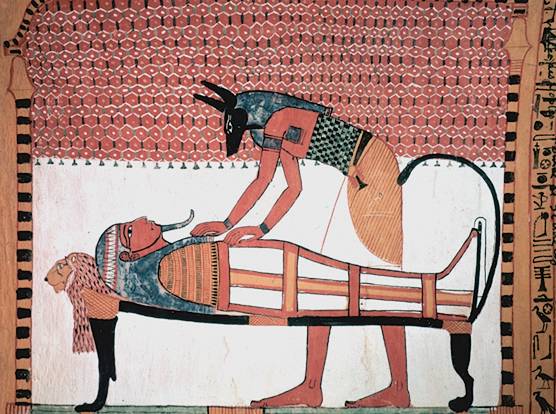The Egyptian Goddess Mafdet was a powerful being who protected the pharaohs of Egypt and king of the gods, Rē. As time passed, Mafdet was slowly written out of history and nearly forgotten. Changes occur with the passing of time, and the Egyptian Goddess Mafdet is no exception.

The first Egyptian dynasty began sometime before 3150 B.C.E. Pharaoh Narmer, the founder of the first dynasty, ruled over a unified Egypt. The land flourished and Egyptian culture was united under one belief. While little is known about this dynasty, the earliest form of Egyptian mythology was recovered from their art and monuments.1 Among their recovered monuments is the Goddess Mafdet, who was a fierce feline goddess from this first dynastic period of Egypt, at the beginning of what historians call the Old Kingdom. She was the royal emblem of the pharaohs and was represented as a protector of royalty.2 Mafdet is depicted with a small head of a lynx resting on a body with slender legs and a small, thick tail. While Mafdet is commonly remember with the head of a lynx, she is also remembered with the head of other various feline creatures, such as a panther, lioness, and leopard.3
Felines were one of the most revered animals of Egyptian culture. The earliest mention of cats in Egypt was around 4000 B.C.E. The people of Egypt considered cats to be protectors of the land and portrayed that notion in their mythology. The earliest wild cats in Egyptian culture protected the villagers from venomous snakes. In gratitude, they left pieces of food for the cats in order to keep them around the village. This led to the domestication of the cat in Egypt. Because of the cat’s protective nature, Egyptians portrayed felines as some of the fiercest goddesses in Egyptian mythology. After playing a significant role in their religious beliefs, cats became sacred creatures.4 Feline worship became a common occurrence. The feline deities became associated with royalty, the sun, and fertility. These goddesses held strong connections with Rē, the king of all gods and god of the sun.5
Snakes have played vast roles in countless mythologies, often portrayed as villainous and deceitful creatures. While there are positive tales involving snakes, a majority are met with fear. In Jewish and Christian mythology, Eve states, “The serpent deceived me, and I ate.”6 In both Jewish and Christian lore, snakes are connected with the devil and with the fall of humanity.7 In Egyptian mythology, there are various gods and goddesses associated with snakes. One of the most common snakes referenced in Egyptian myth is Apophis. He was viewed with fear and as an enemy of the high god Rē. Apophis has been associated with famine and the destruction of Egypt. Another association of Apophis was with the notion of topos, or an inverted world. This world is described as pure chaos and destruction, referencing Apophis as a figure of disharmony.8 While Egyptian mythology has cast a bad light on serpents, a few of these descriptions have been distorted. One example of this distortion is the Egyptological symbol of the ouroboros. The predominantly recognized ouroboros is a depiction of a serpent biting its tail, forming a circle. This symbol has been associated with the end of times and the destruction of humanity in the more modern representations. Before the modern interpretation of the symbol, the ouroboros represented the idea of a protective enclosure with multiple divine levels.9
Killer of snakes, mistress of the House of Life, protector of Rē, and protector of the Pharaoh—the Goddess Mafdet has achieved many titles as an Egyptian Goddess. She is seen as a force of justice and punishment, acting on the orders of the pharaohs and god Rē.
“To say, Rē dawns, his uraeus on his head, against the serpent, which is come out of the earth, (and) which is under the fingers of N. He (N.) cuts off thy head with this knife, which was in the hand of the m3fd.t-lynx, [which lives in the house of life]: he draws, (the teeth) which are upon (in) thy mouth; he saps thy poison with those four strings, which were in the service of the sandals of Osiris. Serpent (beast), lie down; bull, glide away.” – Utterance 29810
Mafdet was considered the protector and right hand of Rē. The goddess is mostly portrayed as a powerful feline goddess that acts as the hand of Rē and protects the world against snakes. Snakes were considered the enemy of Rē. In Utterance 298 from the Pyramid Texts, Mafdet is wielded as the weapon against the mighty snake. Every day after Rē dawns, the process is repeated, and the goddess Mafdet is used as a weapon once more.11

There is a connection between the pharaohs, the god Rē, and Mafdet. Mafdet was connected to Rē in mythology but was also connected to the pharaohs of the first dynasty of Egypt. There was an ancient board game that connected Mafdet, the pharaoh, and the god Rē. Mehen was the snake god that was coiled around Rē. He is mentioned in both dynastic and Old Kingdom mythology. In the game, Mafdet was charged with protecting the pharaoh during his quest to free Rē. This game combined religious aspects of Egyptian mythology.12 While Mafdet was the protector of Rē, she protected the pharaohs as well. She was a symbol of the pharaohs and used as a royal protector.13 Besides having the title of Pharaoh, the kings of Egypt became known as the Sons of the Sun. The Sun, Rē, became associated with these pharaohs. By being called the Sons of the Sun, the pharaohs held a position that was backed by the King of the Gods.14
“The hand of N. which is come upon thee —it is a violent one which is come upon thee, it is the m3fd.t-lynx, which is in the house of life. She strikes thee in thy face; she scratches thee in thine eyes. So that thou fallest in thy dung and glidest in thy urine. Fall, lie down, glide away, so that thy mother Nut may see thee.” – Utterance 29715

Mafdet brutally protects the royalty of Egypt. In Utterance 297, Mafdet is protecting the Pharaoh Unas (also known as Unis). Utterance 297 is describing King Unas and the protection he receives from the Mafdet-lynx and how she was wielded as a weapon. Pharaoh Unas was the final pharaoh of the fifth dynasty. During his reign, Unas constructed a pyramid inscribed with symbols now known as the Pyramid Texts. They were inscribed on the walls of the funerary crypts with the expectation of protection after death and safe passage into the Underworld.16 Another pharaoh that Mafdet was to protect was the Pharaoh and God Osiris. In mythology, Osiris was seen as the first of the pharaohs of Egypt. Osiris was the great-grandson of the god Rē and was one connection between Mafdet and Rē. Mafdet was sworn to protect the god/pharaoh, Osiris, and protect Rē’s bloodline.17 After Osiris was brutally murdered by his brother Seth, the goddess Mafdet was ostracized, and her power waned. It was also claimed that Mafdet was sexually involved with the murderer as well, making her an accomplice. Regardless of her choice of sexual partner, Mafdet failed in her goal of protecting the pharaoh and Rē’s bloodline. Mafdet was written out of history and eventually replaced by other feline goddesses.18
- Toby A.H. Wilkinson, First Dynastic Egypt (Abingdon: Routledge, 1999), 2. ↵
- Alain Anselin, “Les Initiés De L’Aube,” Présence Africaine, Nouvelle Série, no. 149/150 (1989): 28. ↵
- Wolfhabt Westendorf, “Die Pantherkatze Mafdet,” Zeitschrift der Deutschen Morgenländischen Gesellschaft 118, no. 2 (1968): 249. ↵
- Alleyn Diesel, “Felines and Female Divinities: The Association of Cats with Goddesses, Ancient and Contemporary,” Journal for the Study of Religion 21, no. 1 (2008): 78-79. ↵
- Wolfhabt Westendorf, “Die Pantherkatze Mafdet,” Zeitschrift der Deutschen Morgenländischen Gesellschaft 118, no. 2 (1968): 248. ↵
- Genesis 3: 13. ↵
- Jonathan W. Stanley, “Snakes: Objects of religion, fear and myth,” Journal of Integrative Biology 2, no. 2 (2008): 43. ↵
- Ludwig D. Morenz, “Apophis: On the Origin, Name, and Nature of an Ancient Egyptian Anti-God,” Journal of Near Eastern Studies 63, no. 3 (2004): 202-203. ↵
- Dana Michael Reemes, “The Egyptian Ouroboros: An iconological and theological study,” abstract, (PhD diss., UCLA, 2015), ii, https://escholarship.org/uc/item/6c0153p7. ↵
- Samuel A. B. Mercer, The Pyramid Texts, (Andesite Press, 2015), 152. ↵
- Colin Reader, “The Netjerikhet Stela and the Early Dynastic Cult of Ra,” The Journal of Egyptian Archaeology 100 (2014): 431. ↵
- Colin Reader, “The Netjerikhet Stela and the Early Dynastic Cult of Ra,” The Journal of Egyptian Archaeology 100 (2014): 434. ↵
- Alain Anselin, “Les Initiés De L’Aube,” Présence Africaine, Nouvelle Série, no. 149/150 (1989): 28. ↵
- Colin Reader, “The Netjerikhet Stela and the Early Dynastic Cult of Ra,” The Journal of Egyptian Archaeology 100 (2014): 426. ↵
- Samuel A. B. Mercer, The Pyramid Texts, (Andesite Press, 2015), 151. ↵
- Dorothea Arnold, Egyptian Art in the Age of the Pyramids (New York: The Metropolitan Museum of Art, 1999), 22. ↵
- Wolfhabt Westendorf, “Die Pantherkatze Mafdet,” Zeitschrift Der Deutschen Morgenländischen Gesellschaft 118, no. 2 (1968): 250. ↵
- Wolfhabt Westendorf, “Die Pantherkatze Mafdet,” Zeitschrift Der Deutschen Morgenländischen Gesellschaft 118, no. 2 (1968): 255. ↵



15 comments
Evangelina Villegas
This was an amazing and well-written article that was very informative. I have always been a fan of mythology and I like to learn about the mythology from other cultures as I find them to be interesting. I have read about Egyptian mythology before, but I never knew about Mafdet until now and to know of her story was really cool. This article has helped widen my knowledge on Egyptian culture just a bit more.
Haik Tatevosyan
I found this article to be very informative and interesting because Im really into other religions and cultures. To see what they believe in and how they are brought up from the religious perspective is very eye opening for most and I always find it very entertaining to learn more and more about the different kinds of religions.
Trenton Boudreaux
Very well written article. I am glad to see Egyptian mythology being talked about more rather than the Greek or Norse as those have been done to death. Egyptian mythology is a weird one with Gods and Goddesses changing roles and names over time. While I had heard of Set, Osiris, and the like, the goddess Mafdet is one I have never heard of.
Madelynn Vasquez
The Egyptians were far ahead of their time and you can really see this when you learn about their belief systems and ideologies. These ways seem so archaic, yet in modern times, at least in the Western world, these beliefs are becoming more prominent amongst a younger generation. Alongside Greek mythology, there is a beauty that can be seen in Egyptian mythology, so thank you for sharing this wonderful article!
Danielle Litman
I chose to read this article to better deepen my knowledge of other countries’ religious beliefs and historical backgrounds. Unfortunately, in the United States public education, students’ historical knowledge has been white washed. I found the story of the goddess Mafdet very intriguing. She was a strong powerful goddess, but then suddenly she was written out of history for one mistake. I pose a hypothetical question, do you think Mafdet actually did betray Osiris or because since she is a goddess, a female, Mafdet was just a scapegoat?